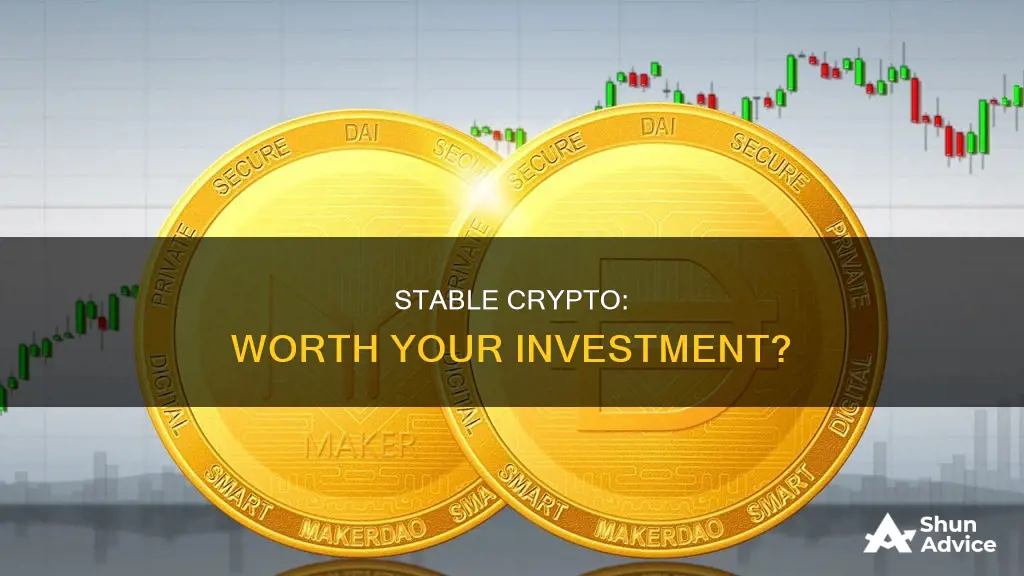
Stablecoins are a type of cryptocurrency that is designed to maintain a fixed value over time. They are less volatile than traditional cryptocurrencies because they are backed by reserve assets, such as the U.S. dollar, gold, or other commodities. This makes them an attractive option for investors who are interested in gaining exposure to cryptocurrency but are wary of its rampant volatility. However, the same feature that makes them stable also limits their potential for explosive gains. In this article, we will explore the pros and cons of investing in stablecoins and discuss whether they are a worthwhile investment option.
| Characteristics | Values |
|---|---|
| Definition | A stablecoin is a digital currency that is linked to an underlying asset such as a national currency or a precious metal such as gold. |
| Purpose | To help manage volatility in the cryptocurrency markets. |
| Comparison to other cryptocurrencies | Stablecoins are less subject to volatility as they are backed by an asset, most often a fiat currency. |
| Types | Fiat-backed, cryptocurrency-backed, and commodity-backed stablecoins. |
| Examples | Tether (USDT), USD Coin (USDC), and Dai (DAI). |
| Advantages | Stability, liquidity, good source of passive income, store of value. |
| Disadvantages | Reduced rewards, lack of regulation, not fully decentralised, risk of major losses. |
What You'll Learn

Stablecoins are less volatile than other cryptocurrencies
Stablecoins are a type of cryptocurrency that is designed to maintain a fixed value over time. They are less volatile than other cryptocurrencies because they are pegged to a specific real-world currency, often the US dollar. In this setup, one unit of the cryptocurrency typically equals one unit of the real currency.
Stablecoins are often backed by the specific assets they are pegged to. For example, the organisation issuing a stablecoin will typically set up a reserve at a financial institution that holds the underlying asset. So, a stablecoin could hold $100 million in reserve and issue 100 million coins with a fixed value of $1 per coin. If a stablecoin's owner wants to cash out the coin, the real money can ultimately be taken from the reserve.
Stablecoins can also be algorithmic, meaning they use technical means (such as destroying some of the coin supply to create scarcity) to keep the price of the crypto coin at a fixed value. These can be riskier than stablecoins backed by assets.
Stablecoins are also less volatile because they are designed to be used for real transactions. "Digital currencies like Bitcoin and Ethereum are tremendously volatile, which makes pricing things in their terms very difficult," says Anthony Citrano, founder of Acquicent, a marketplace for NFTs. "Stablecoins avoid this issue by locking their prices to a known reserve currency."
SHA Coin: A Smart Investment Move?
You may want to see also

Stablecoins are pegged to stable assets
Stablecoins are a type of cryptocurrency that is designed to maintain a fixed value over time. They are pegged to stable assets, which can be a financial instrument (e.g., stocks), currency (e.g., US dollar), or commodity (e.g., gold). This means that their value is tied or 'pegged' to the price of the underlying asset, making them less volatile than other cryptocurrencies. For example, if a stablecoin is pegged to gold and the price of gold increases, the stablecoin will also increase in value.
Most stablecoins are pegged to the US dollar because it is one of the most stable currencies globally, making them a less volatile investment option. However, it is important to note that some stablecoins depend on computer codes and market forces to maintain their value, and these can be more volatile. For example, the stablecoin LUNA faced a significant price drop during a turbulent market.
Stablecoins are a good option for investors who want to gain exposure to cryptocurrency but are wary of its rampant volatility. They are also a good source of passive income, as many crypto exchanges offer predictable interest rates of between 3% to 20% annually. Additionally, stablecoins can be used for quick and cheap payments or money transfers on a global scale, providing a fast way to transfer deposits or withdrawals between fiat currencies and cryptocurrency exchanges.
Despite their benefits, there are also risks associated with investing in stablecoins. Firstly, they are not fully decentralised because they are pegged to a major asset. This means that if the asset crashes, the stablecoin will also crash, potentially resulting in major losses. Secondly, stablecoins are not regulated by government or financial institutions, so there is no guarantee that they will maintain their value. Lastly, some stablecoins, like LUNA, are not backed by anything of real value and are solely based on market demand and computer code, making them very volatile.
In conclusion, stablecoins are a good investment option for those seeking a less volatile cryptocurrency. However, it is important to carefully consider the risks before investing and to only stake what you can afford to lose.
Bullion Coins: Silver Investment Strategy for Beginners
You may want to see also

Stablecoins are a good source of passive income
Stablecoins, such as Tether, offer a stable investment opportunity with lower volatility than classic crypto assets like Bitcoin and Ethereum. Their value is tied to or 'pegged' to another currency or commodity, providing a level of stability and making them suitable for common transactions. The stability of stablecoins allows investors to hold them as interest-bearing assets, earning passive income through interest rates offered by exchanges and lending platforms.
The passive income potential of stablecoins is further enhanced by their ease of use and liquidity. They are highly liquid and tradable, making it simple to exchange them into other cryptocurrencies or fiat currencies. This liquidity also makes stablecoins a powerful tool for quick and cheap global payments or money transfers. The stability and liquidity of stablecoins make them an attractive option for investors seeking passive income through interest and lending, without the high risk and volatility associated with other cryptocurrencies.
Stablecoins also provide an opportunity for investors to earn passive income through staking rewards. By participating in maintaining the flow of the blockchain network, investors can earn compensation in the form of staking rewards. This process is similar to depositing money in a savings account and can be a stable source of passive income for stablecoin holders.
While stablecoins offer stability and passive income opportunities, it is important to consider the risks involved. Stablecoins are subject to security risks, counterparty risks, reserve risks, and lack of confidence, as highlighted by the plunge of TerraUSD. Therefore, due diligence and careful research are essential before investing in stablecoins.
Crypto Investment Guide: Getting Started in Cryptocurrency
You may want to see also

Stablecoins are a store of value
Stablecoins are a type of cryptocurrency designed to maintain a fixed value over time. They are linked or "pegged" to an underlying asset, usually a national currency like the US dollar or a precious metal like gold. This makes them a store of value.
Stablecoins are less volatile than other cryptocurrencies and provide a predictable haven within the volatile world of cryptocurrency. Their value is stable over time, at least relative to the currency they are pegged to. For example, one unit of a stablecoin pegged to the US dollar would be worth one US dollar.
Stablecoins are often backed by the specific assets they are pegged to. For instance, the organisation issuing a stablecoin might set up a reserve at a financial institution that holds the underlying asset. So, if a stablecoin is pegged to the US dollar, the organisation might hold $100 million in reserve and issue 100 million coins, each with a fixed value of $1. If a stablecoin owner wants to cash out, the real money can be taken from the reserve.
Stablecoins can also be backed by other assets, such as commercial paper, secured loans, corporate bonds, funds, and precious metals. Some stablecoins are not backed by any assets at all but instead use technical means to keep the price stable, such as destroying some of the coin supply to create scarcity. These are known as algorithmic stablecoins and can be riskier than asset-backed stablecoins.
Stablecoins are useful for investors who want exposure to cryptocurrency but are wary of its volatility. They are also useful for making quick and cheap payments or money transfers on a global scale.
Dogecoin: Losing More Than You Invest?
You may want to see also

Stablecoins are not fully decentralised
Stablecoins are a type of cryptocurrency that aims to provide price stability by pegging its value to an external asset, such as the US dollar or gold. While stablecoins offer a less volatile option for investors, it is important to note that they are not fully decentralised.
The decentralised nature of cryptocurrencies is one of their key features, setting them apart from traditional fiat currencies. However, stablecoins, particularly those that are fiat-backed, introduce an element of centralisation. This is because a third-party entity, such as an exchange or financial institution, is responsible for holding the reserves that back the stablecoin's value. This goes against the concept of decentralisation, as investors must trust that the central authority is maintaining sufficient reserves to support the stablecoin's value.
For example, Tether (USDT), the first stablecoin, is a centralised stablecoin held by an exchange. Its solvency relies on the strength of its reserves, which include cash and other assets. Another example is USD Coin (USDC), which is managed by Circle and Coinbase. In these cases, the stability of the stablecoin depends on the actions and integrity of the central authority, rather than being fully decentralised.
While stablecoins provide a bridge between traditional finance and cryptocurrency markets, offering investors a unique opportunity, it is important to understand the risks involved. The centralisation of fiat-backed stablecoins introduces counterparty risk, as the value of the stablecoin is tied to the actions and stability of the third-party entity. This differs from fully decentralised cryptocurrencies, where value is determined by market forces and the actions of a distributed network of users.
Therefore, while stablecoins offer the benefits of reduced volatility and increased liquidity, they also introduce elements of centralisation and associated risks. As such, investors considering stablecoins should carefully evaluate the level of centralisation and the associated risks before making investment decisions.
Jamie Dimon's Stance on Crypto Investing
You may want to see also
Frequently asked questions
Stablecoins are cryptocurrencies pegged to a stable asset, which could be a financial instrument (stock), currency (US dollar), or commodity (gold).
Stablecoins are less volatile than other cryptocurrencies and are a good source of passive income. They are also a store of value, maintaining their value or even increasing when the market is crashing.
Stablecoins are not fully decentralised, not regulated, and some lack real backing. If the asset a stablecoin is pegged to crashes, the stablecoin will also crash.
Stablecoins are a good investment for those looking for a less volatile cryptocurrency. However, they offer lower returns than other cryptocurrencies and there are risks to investing in them, so it depends on how much risk an investor is willing to take.







